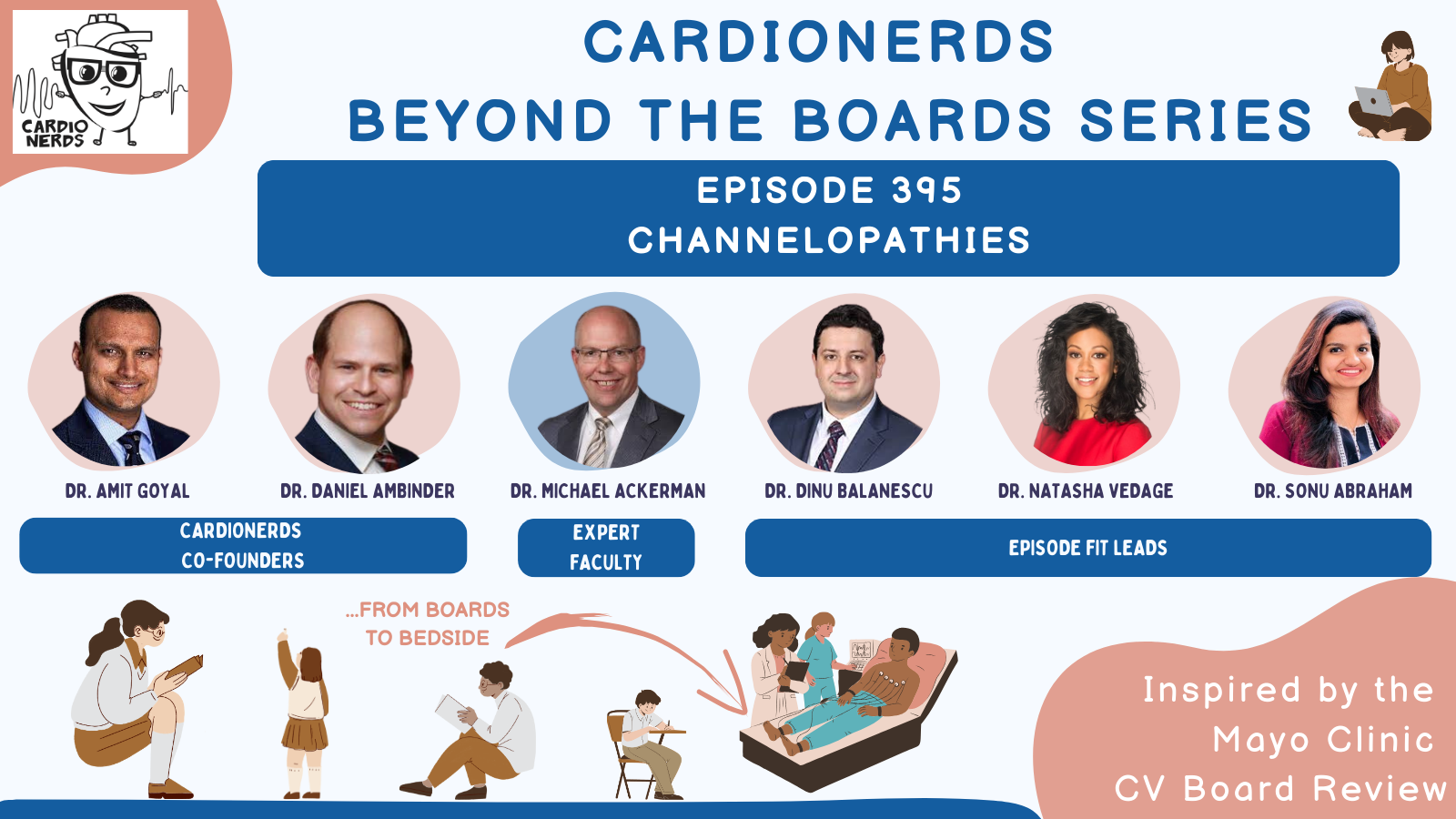395. Beyond the Boards: Channelopathies with Dr. Michael Ackerman
Description
Dr. Amit Goyal, along with episode chair Dr. Dinu Balanescu (Mayo Clinic, Rochester), and FIT leads Dr. Sonu Abraham (University of Kentucky) and Dr. Natasha Vedage (MGH), dive into the fascinating topic of channelopathies with Dr. Michael Ackerman, a genetic cardiologist and professor of medicine, pediatrics, and pharmacology at Mayo Clinic, Rochester, Minnesota. Using a case-based approach, they review the nuances of diagnosis and treatment of channelopathies, including Brugada syndrome, catecholaminergic polymorphic ventricular tachycardia (CPVT), and long QT syndrome. Dr. Sonu Abraham drafted show notes. Audio engineering for this episode was expertly handled by CardioNerds intern, Christiana Dangas.
The CardioNerds Beyond the Boards Series was inspired by the Mayo Clinic Cardiovascular Board Review Course and designed in collaboration with the course directors Dr. Amy Pollak, Dr. Jeffrey Geske, and Dr. Michael Cullen.
American Heart Association’s Scientific Sessions 2024
- As heard in this episode, the American Heart Association’s Scientific Sessions 2024 is coming up November 16-18 in Chicago, Illinois at McCormick Place Convention Center. Come a day early for Pre-Sessions Symposia, Early Career content, QCOR programming and the International Symposium on November 15. It’s a special year you won’t want to miss for the premier event for advancements in cardiovascular science and medicine as AHA celebrates its 100th birthday. Registration is now open, secure your spot here!
- When registering, use code NERDS and if you’re among the first 20 to sign up, you’ll receive a free 1-year AHA Professional Membership!
US Cardiology Review is now the official journal of CardioNerds! Submit your manuscript here.
<figure class="wp-block-post-featured-image">
 </figure>
</figure>CardioNerds Beyond the Boards Series
CardioNerds Episode Page
CardioNerds Academy
Cardionerds Healy Honor Roll
CardioNerds Journal Club
Subscribe to The Heartbeat Newsletter!
Check out CardioNerds SWAG!
Become a CardioNerds Patron!
Pearls and Quotes – Channelopathies
- One cannot equate the presence of type 1 Brugada ECG pattern to the diagnosis of Brugada syndrome. Clinical history, family history, and/or genetic testing results are required to make a definitive diagnosis.
- The loss-of-function variants in the SCN5A gene, which encodes for the α-subunit of the NaV1.5 sodium channel, is the only Brugada susceptibility gene with sufficient evidence supporting pathogenicity.
- Exertional syncope is an “alarm” symptom that demands a comprehensive evaluation with 4 diagnostic tests: ECG, echocardiography, exercise treadmill test, and Holter monitor. Think of catecholaminergic polymorphic ventricular tachycardia (CPVT) in a patient with exertional syncope and normal EKG!
- ICD therapy is never prescribed as monotherapy in patients with CPVT. Medical therapy with a combination of nadolol plus flecainide is the current standard of care.
- Long QT syndrome is one of the few clinical scenarios where genetic testing clearly guides management, particularly with respect to variability in beta-blocker responsiveness.
Notes – Channelopathies
1. What are the diagnostic criteria for Brugada syndrome (BrS)?
Three repolarization patterns are associated with Brugada syndrome in the right precordial leads (V1-V2):
- Type 1: Prominent coved ST-segment elevation displaying J-point amplitude or ST-segment elevation ≥2 mm, followed by a negative T wave.
- Type 2/3: Saddleback ST-segment configuration with variable levels of ST-segment elevation.
It is important to note that only a type 1 pattern is diagnostic for Brugada syndrome, whereas patients with type 2/3 patterns may benefit from further testing.
The Shanghai score acknowledges that relying solely on induced type 1 ECG changes has limitations. Therefore, one cannot equate the presence of a type 1 Brugada ECG pattern alone to the diagnosis of Brugada syndrome. The score suggests incorporating additional information—such as clinical history, family history, and/or genetic testing results—to achieve a definitive diagnosis.
2. What is the significance of genetic testing in Brugada syndrome?
There are 23 alleged Brugada syndrome susceptibility genes published with varying levels of evidence. However, only one gene mutation, the loss-of-function variants in the SCN5A gene encoding for the α-subunit of the NaV1.5 sodium channel, is considered to have sufficient evidence.
The overall yield of BrS genetic testing is 20%. The presence of PR prolongation (>200 ms) along with type I EKG pattern increases the yield to 40%. On the contrary, in the presence of a normal PR interval, the likelihood of SCN5A positivity drops to <10%.
3. How would you risk-stratify a patient with Brugada syndrome?
Serious arrhythmic events (SAE), including resuscitated cardiac arrest and sudden cardiac death, rarely represent the initial symptoms of Brugada syndrome.





